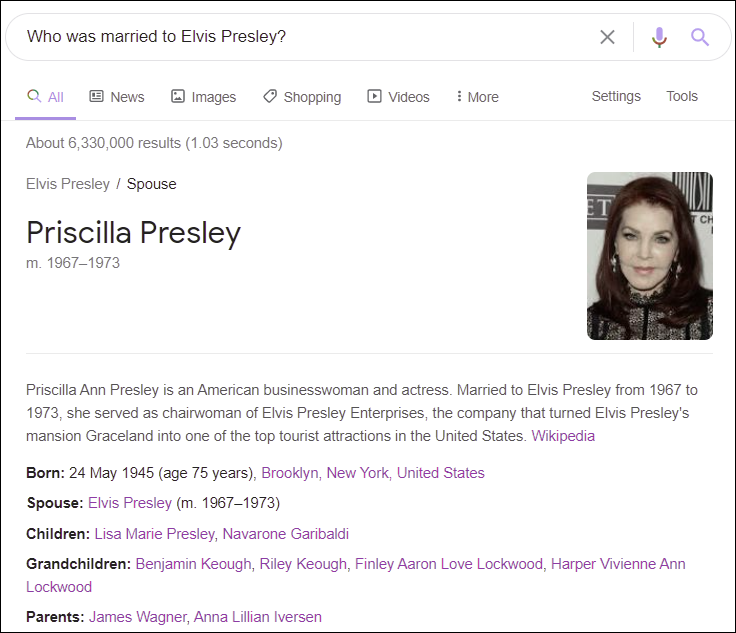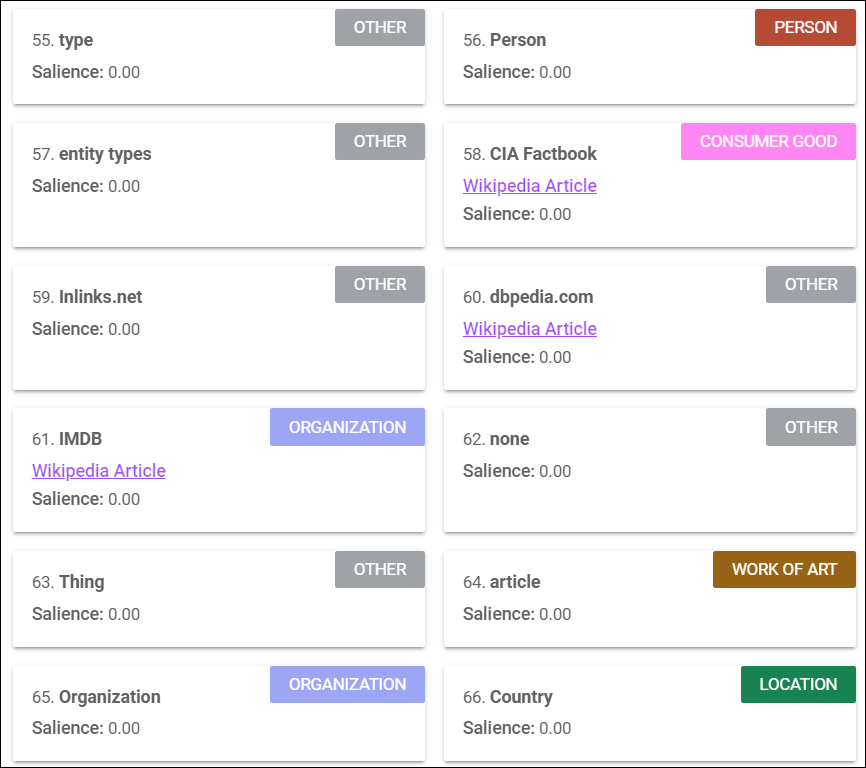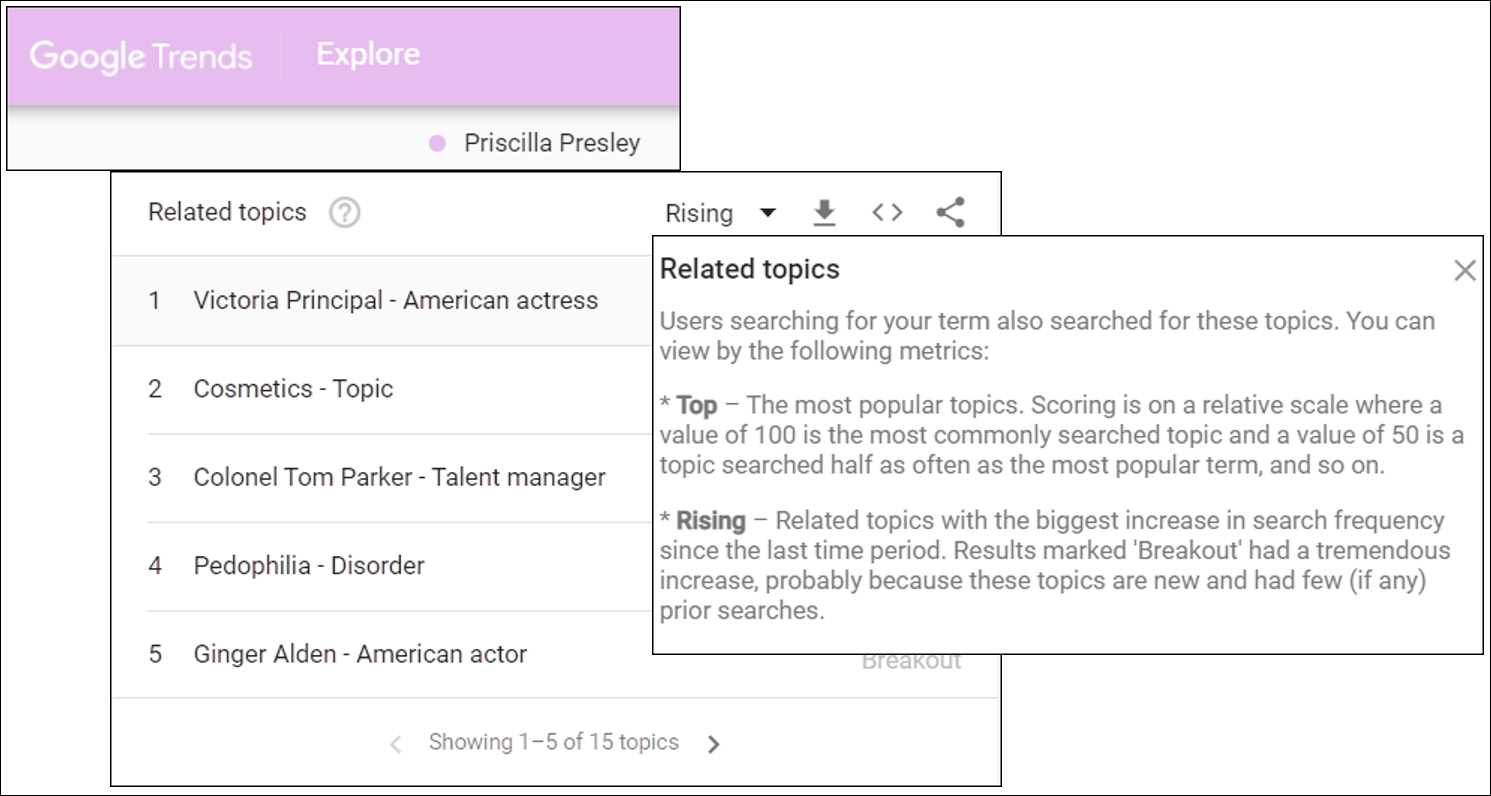Knowledge Graphs can help search engines like Google leverage structured data about topics.
Semantic data and markup, in turn, help to connect concepts and ideas, making it easier to turn them into structured data to populate Google’s Knowledge Graph.
SEO professionals need to understand how to influence topics in the graph if they are to affect meaningful change in Google’s understanding of their content.
What Is Google’s Knowledge Graph?
I like to think of a knowledge graph as a cross between an encyclopedia and a database. Each article is called an “Entity” by developers, or a “Topic” in Google’s customer-facing articles.
A topic can be about anything. Like most databases, it has a unique identifier, which you can sometimes see in Google’s URLs. Something like: [kgmid=/g/11f0vfyswk&hl], although the parameter name “kgmid” can change depending on the topic type.
There are usually multiple statements about the topic:
- A name or label (Like “Elvis Presley”).
- A Type or Types (Like “Person”).
- A Description (Say “Singer”).
- A list of Image URLs (Usually with the associated usage rights).
- A Detailed Description (Usually some Text with a URL of the source).
However, Google also states that while the information in the above list might be available directly in their search API, they augment this data considerably internally.
So the topic, in this case, might also include the date Elvis was born and died.
It might say he was married to Priscilla Presley.
His works of art might include “Hound Dog”.
The list could go on.
You can see how this is really not very different from an encyclopedia article, but because all of the facts are in fields like “Married to,” it becomes much easier for a machine to connect the dots between topics.
It also supports the machine in retrieving the right information at the right time when a person asks (for example). “Who was married to Elvis Presley?”
 An example of Google leveraging its Knowledge Graph
An example of Google leveraging its Knowledge GraphAn Important Note on Disambiguation
There are many knowledge graphs in the world. The Google knowledge graph is just one. Others include dbpedia.com, Wikidata.org and Inlinks.net (full disclosure: my company).
Indeed, any semi-structured data could be described as a knowledge graph, including encyclopedias or databases like IMDB.
Google is known to have built out its knowledge graph initially from other data sets including Wikipedia and the CIA Factbook.
There is also a common misconception that Google’s Knowledge Panel is Google’s Knowledge Graph. This is not the case, although the Knowledge panel may represent a subset of data in the graph.
The Knowledge Panel is a visualization of items of data connected through Google’s Knowledge Graph, but Google’s knowledge graph is a less visual record about topics.
A final disambiguation is in the terminology. A Knowledge Graph is generally described as being made up of “Entities” but Google tends to refer to entities as “Topics” in its public documentation.
This is a more “user-friendly” word to use but can make it harder to know when Google refers specifically to entities. This article will use the phrases interchangeably.
Entity Topic Types
Any entity is generally given a topic type. It may be a Person; Organization; Event; Place or Country.
If it is none of these, it is usually simply labeled as a “Thing,” although entity types might continue to be developed by Google.
Google’s Natural Language Processing API gives clues to suggest that many entity types are being used, such as “Work of Art” and “Consumer Good.”
Many others are listed on their Knowledge Graph Search API developer page, but Google currently seems quite weak at correctly categorizing many entities.
In addition, primary research conducted weekly by my company indicates that less than 20% of entities are recognized entities in Google’s own Natural Language Processing algorithm than are returned in their public offering.
 Topic Labels in Google’s NLP output
Topic Labels in Google’s NLP outputSome Benefits of the Knowledge Graph (for Google)
By organizing the world’s information by topic, rather than by crawling and simply indexing webpage and websites, a search engine can leverage several benefits. These include scale, diversity, information integrity, and speed.
Scaling Benefit
The number of webpages is a hotly contested subject and while many argue they are countless, they are certainly in the trillions and expanding at a vast rate every day.
By contrast, the number of topics understood by humanity is much smaller (perhaps in the order of hundreds of billions) and is growing at a far smaller rate.
This means that there is an inordinate duplication of ideas in the content on the web.
By storing the information about a topic in a semi-structured way, the world’s information takes a lot less space and has a lot less duplication.
Diversity of Data Sources Benefit
Storing information about a topic allows Google to cite multiple data sources, rather than always sending the user to a single webpage.
This means that Google can collate salient facts about a topic and display them on the screen or through other mediums in a more appropriate way for the user or the user’s query.
In addition, information about a topic can in theory be derived from other sources beyond the Internet.
Information Integrity Benefit
Whilst Google’s Knowledge Graph can still contain factual inaccuracies and errors and may be open to manipulation by SEO professionals or bad actors, the approach has the benefit of providing Google with a “single point of truth” — at least for non-controversial topics.
A new fact about a topic may have to pass some quality threshold before it is added to the Knowledge Graph, but these thresholds are unlikely to be discussed openly by Google.
On the negative side, a single point of truth can reduce the diversity of information and can be prone to bias if the underlying data sources are themselves biased.
Information Retrieval (Speed) Benefits
By organizing information by topic, it becomes much faster to retrieve information — both by Google and by the user looking for a needle in a haystack.
How It Works: Where You See Google’s Knowledge Graph Used
Having explained how the Knowledge Panel is not the same as the Knowledge Graph itself, it remains the most overt use of the Knowledge Graph for most SEO pros.
However, for many Android Smartphone users, the most prevalent use of the knowledge graph is in fact in the “Discover” feature on their home screen each day.
Google can use information about your behavior to understand what Topics are important to you and can surface-related topics based on user history.
Topics can also be seen in Google Trends.
From here, Google also gives an indication of topics that might be closely related to each other, although it appears that this data is currently gleaned from pulling other searches by the same users, which can sometimes lead to rather unexpected related Topic lists.
 Related Topics in Google Trends are not based on Semantics
Related Topics in Google Trends are not based on SemanticsGoogle also provides a Knowledge Graph Search API as shown above, and surfaces entities in the output of its NLP API.
Google Search: As well as the Knowledge Panel, when you type in a question in Google Search that it can answer using the Knowledge Graph, you also get a rich display in the SERPS. This is often at the expense of the core search results, pushing links to websites way below the fold.
These answers are also then in a format that Google can use in voice search. The Priscilla screenshot is an example of this:
 Images grouped by a Knowledge Graph Topic
Images grouped by a Knowledge Graph TopicEntities also are highly visible in Image Search, often grouping images around a notable person or place in particular.
This is an excellent example of how the Knowledge Graph can be used to act as a repository for other data sources than webpages.
More Resources:
- How to Maximize Your Reach Using Google’s Knowledge Graph
- How to Get Your Brand in Google’s Knowledge Graph Without a Wikipedia Page
- How Search Engines Work
Image Credits
All screenshots taken by author, March 2021





